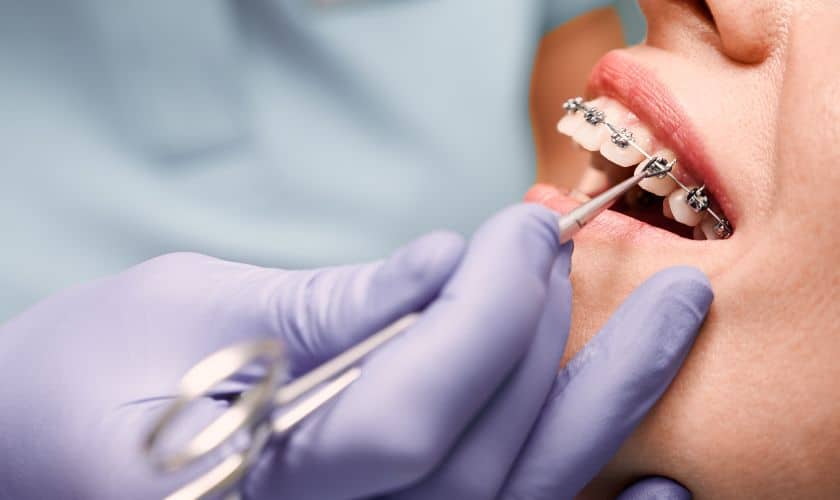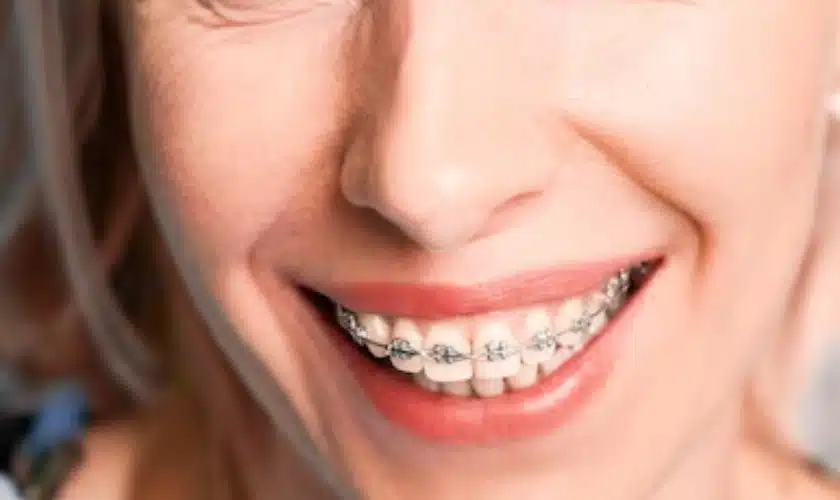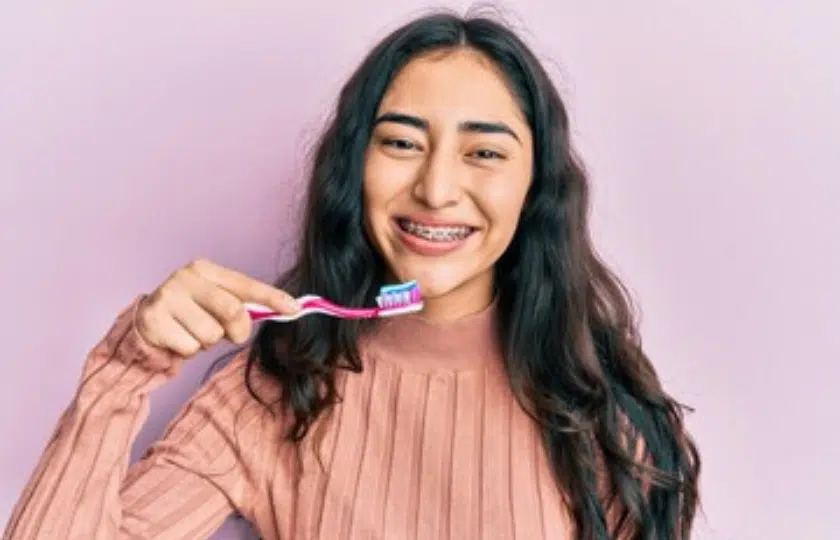
Posts Tagged ‘Braces’


Which is better, Invisalign or braces?
Achieving a perfect smile often involves deciding between Invisalign and traditional braces. At Weaver Orthodontics, we understand the significance of this choice, and we’re here to guide you through the decision-making process.Understanding Invisalign:
Invisalign has gained popularity as a discreet and convenient alternative to traditional braces. This system utilizes a series of clear aligners that gradually shift your teeth into the desired position. The aligners are removable, allowing you to maintain your oral hygiene easily. One of the key advantages of Invisalign is its virtually invisible appearance. This makes it an ideal choice for individuals who may feel self-conscious about wearing traditional braces. The aligners are custom-made for a comfortable fit, and there are no wires or brackets to cause irritation. However, Invisalign may not be suitable for complex orthodontic issues. It is highly effective for mild to moderate cases, such as overcrowded or spaced teeth. Compliance is crucial; for optimal results, patients must wear the aligners for 20 to 22 hours a day.Decoding Traditional Braces:
Traditional braces have been a trusted orthodontic method for decades, and advancements have made them more comfortable and aesthetically pleasing. Braces consist of metal brackets attached to the teeth and connected by wires. Today, you can choose colored bands for a fun and personalized touch. One significant advantage of braces is their effectiveness in treating various orthodontic issues, including severe misalignments and complex bite problems. The constant pressure applied by the braces ensures a controlled and efficient tooth movement process. While traditional braces are visible, they have evolved to be more comfortable and less conspicuous. Modern brackets are smaller, and advancements like tooth-colored brackets provide a more subtle appearance.Comparing the Two:
When deciding between Invisalign and braces, several factors come into play. Visibility: Invisalign is renowned for its discreet appearance, making it an excellent choice for those who prefer a less noticeable treatment. Comfort: Invisalign’s smooth plastic aligners generally cause less irritation than the wires and brackets of traditional braces. Additionally, there are no dietary restrictions with Invisalign, as the aligners are removable during meals. Treatment Duration: Both Invisalign and braces can achieve remarkable results, but the duration of treatment varies. In some cases, Invisalign may provide quicker results for certain orthodontic issues. Complex Cases: Traditional braces are often more suitable for complex orthodontic cases, while Invisalign is ideal for less severe issues. Maintenance: Invisalign offers the advantage of easy maintenance due to the removable aligners, allowing for thorough oral hygiene routines. Traditional braces require extra care to clean around brackets and wires.Making Your Decision:
Choosing between Invisalign and traditional braces ultimately depends on your specific needs, lifestyle, and preferences. At Weaver Orthodontics, our experienced orthodontists will assess your case, discuss your goals, and provide personalized recommendations. Whether you opt for the discreet flexibility of Invisalign or the time-tested reliability of traditional braces, the end goal remains the same – a beautiful, healthy smile. Your choice should align with your comfort, lifestyle, and treatment objectives.Conclusion:
In the Invisalign vs. braces debate, there is no one-size-fits-all answer. Weaver Orthodontics is here to help you make an informed decision based on your unique circumstances. Your journey to a perfect smile starts with a consultation, where we’ll explore the best path for you, ensuring a confident and radiant smile that lasts a lifetime.
How Braces Can Correct Bite Issues and Improve Your Oral Health
A confident and radiant smile is often the result of well-aligned teeth and a properly functioning bite. For those facing bite issues or misaligned teeth, braces emerge as a transformative solution. In this article, we delve into the significant role that braces play in correcting bite issues and enhancing overall oral health, with a special focus on the expertise provided by Weaver Orthodontics in Brunswick.Understanding Bite Issues
Bite issues, also known as malocclusions, can manifest in various forms, such as overbites, underbites, and crossbites. These conditions not only affect the aesthetic appeal of your smile but also impact the functionality of your teeth and jaw. Untreated bite issues can lead to oral health problems like tooth decay, gum disease, and even jaw pain.The Role of Braces
1. Alignment Correction
Braces are designed to gradually move teeth into their optimal positions, addressing misalignments and bite issues. Using a combination of brackets, wires, and bands, braces apply gentle pressure to guide teeth into the desired alignment. This process is crucial for achieving a harmonious bite and a visually pleasing smile.2. Bite Correction
Different types of braces, including traditional metal braces, clear braces, and Invisalign, offer effective solutions for correcting various bite issues. Overbites, where the upper teeth overlap the lower ones, can be corrected by adjusting the alignment. Underbites, characterized by lower front teeth extending beyond the upper ones, can also be effectively addressed with braces.3. Oral Health Improvement
Beyond aesthetic benefits, braces contribute significantly to improving oral health. Straightening teeth and correcting bite issues make oral hygiene practices more effective, reducing the risk of cavities and gum disease. A well-aligned bite also helps in preventing excessive wear on teeth, reducing the likelihood of issues like temporomandibular joint (TMJ) disorders.Weaver Orthodontics: Expertise in Brunswick
In Brunswick, Weaver Orthodontics stands out as a trusted provider of orthodontic solutions. With a team of skilled orthodontists and a commitment to personalized care, Weaver Orthodontics offers a range of braces options tailored to individual needs. Their expertise extends beyond conventional braces, incorporating modern and discreet options like clear braces and Invisalign.Conclusion
Investing in braces in Brunswick not only transforms your smile but also addresses underlying bite issues for improved oral health. Weaver Orthodontics, with its commitment to excellence, provides a reliable and personalized approach to orthodontic care. Embrace the journey to a confident smile, optimal bite, and enhanced oral well-being with the transformative power of braces.
From Shy to Confident: How Adult Braces Can Boost Self-Esteem
Do you feel self-conscious about your crooked teeth or a misaligned bite? Are you hesitant to smile in public because of your dental imperfections? You’re not alone. Many adults struggle with insecurity and anxiety due to their orthodontic issues. But don’t despair! Adult braces can transform more than just your smile – they can boost your confidence and enhance your overall well-being. In this post, we’ll explore how adult braces can help you go from shy to confident and why investing in yourself is always worthwhile.,Introduction to Adult Braces
There are many reasons why adults may choose to seek orthodontic treatment, but one of the most common is a desire to improve their self-esteem. In our society, having straight teeth is often seen as a sign of success, health, and attractiveness. As we age, our teeth can gradually become crooked or crowded, making us self-conscious about our appearance.
Adult braces are an effective way to correct these problems and give you the confidence boost you need. Our practice offers various braces options for adults, including clear braces and invisible aligners. We will work with you to create a treatment plan that meets your needs and goals.
We encourage you to contact our office to schedule a consultation if you consider adult braces. During your consultation, we will happily answer any questions, and help you determine if this treatment option is right.
Benefits of Adult Braces
Adult braces come with some benefits that can help to boost self-esteem:- They can improve the appearance of your smile. It can be a huge confidence booster if you’re self-conscious about your teeth.
- They can correct any misalignment issues with your teeth. It can also help to improve the way your teeth look and feel.
- Adult braces can help to protect your teeth from future damage.
Different Types of Braces
There are many different types of braces that adult patients can choose from, depending on their needs and budget. Metal braces are the most common type of braces, and they are also the most affordable. Ceramic braces are made of clear or tooth-colored brackets, making them less noticeable than metal braces. Lingual braces are placed on the backside of the teeth, making them invisible from the front. Invisalign is a popular alternative to traditional braces that uses clear plastic aligners to straighten teeth gradually.
Braces can be an effective way to improve your smile and boost your self-esteem. If you are considering braces, talk to your orthodontist about which type would be best for you.How Wearing Braces Can Boost Self-Confidence?
Wearing braces can boost self-confidence for some reasons. First, when you have straight teeth, you tend to smile more. Smiling is one of the quickest ways to show confidence. Secondly, when your teeth align, you may feel better about yourself overall, increasing confidence in social and professional situations. Third, adults who have had braces often report feeling more attractive after their treatment is complete. This boost in attractiveness can lead to improved self-esteem and greater confidence in all areas of your life.Steps for Choosing the Right Type of Brace
Many different braces are available on the market today, and choosing the right type of brace for your needs can be daunting. Here are a few steps to help you choose the right type of brace for your needs:Determine what type of braces will best suit your needs. Many different braces are available, from traditional metal braces, to clear ceramic ones. You should consult your orthodontist to determine which braces best suit your needs.
Consider your budget when choosing a type of brace. Braces can be expensive, so it is important to consider your budget when choosing a type of brace. Metal braces are the most affordable option, while clear ceramic braces are typically more expensive.
Ask about insurance coverage. Many insurances plan to cover at least part of the braces cost, so be sure to ask about coverage before making your final decision.
Schedule a consultation with an orthodontist. Once you have determined which type of brace is right for you, schedule a consultation with an orthodontist to get fitted for your new braces!
Cost Considerations for Adult Braces
There are many cost considerations to take into account when getting adult braces. The type of braces, the length you need to wear them, and whether or not you have insurance coverage are all important factors.
The average cost of braces is $5,000 to $6,000 but can range anywhere from $2,500 to $10,000 depending on the severity of your case and the type of braces you choose. Metal braces are typically the most affordable option, followed by ceramic braces. Lingual braces (braces placed on the back of your teeth) and Invisalign (clear, virtually invisible aligners) are usually the most expensive options.
If your insurance plan covers orthodontic treatment, you will likely only be responsible for a portion of the total cost. However, checking with your insurer beforehand is important to know what is covered. Some plans may only cover a certain percentage of the total cost or have a maximum lifetime benefit for orthodontic treatment.
Financing options can make adult braces more affordable. Many orthodontists offer in-house financing plans with low down payments and interest-free monthly payments throughout treatment. Several third-party financing companies offer loans for dental procedures, including orthodontic treatment. Be sure to compare interest rates and repayment terms before selecting a financing option to ensure you get the best deal possible.
Frequently Asked Questions about Adult Braces
-How much do adult braces cost?
-Are there different types of adult braces?
-How long does it take to get results from adult braces?
-What are the side effects of adult braces?
-Do I need a referral from my dentist to get adult braces?
The cost of adult braces varies depending on the type and severity of the person’s dental issue. Traditional metal braces are typically the most affordable option, while clear or ceramic braces are more expensive. The time needed to achieve results also varies, but is typically shorter for adults than for children since adults’ teeth are already fully developed. Side effects from adult braces are usually minor and temporary, such as increased saliva production, discomfort, and soreness. In most cases, a referral from a dentist is not required to get adult braces.
Conclusion
Adult braces can be a great way to boost self-esteem and help people overcome the shyness often associated with misaligned teeth. Having straight teeth makes people look better and gives them more confidence in social situations. This article has provided useful information about how adult braces can improve your self-image and make you feel more confident. If you think adult braces may be the right choice, talk to your dentist today!

An Essential Guide To Choosing The Right Toothbrush When You Have Braces
Braces are an investment in your future dental health, but they can also make it difficult to find the right products. One of the most important tools in your oral hygiene toolkit is a toothbrush but with so many options available, how do you know which one is best for you? This guide will provide essential tips for choosing the right toothbrush when you have braces. From selecting a brush head size and material to understanding what type of bristles work best for your orthodontic appliance, we’ll cover everything you need to know so that you can keep your smile healthy — even with braces!Different types of toothbrushes
When you have braces, it is important to choose the right toothbrush to ensure that your teeth and gums are properly cleaned. There are three main types of toothbrushes: manual, electric, and sonic. Manual toothbrushes are the most common type of toothbrush. They come in a variety of shapes and sizes and can be used with different bristles (soft, medium, or hard). Electric toothbrushes are also becoming more popular. They are battery-operated and vibrate to help remove plaque and debris from teeth. Sonic toothbrushes are the newest type of toothbrush on the market. They use ultrasonic waves to clean teeth and are said to be more effective than manual or electric toothbrushes. No matter which type of toothbrush you choose, it is important to brush your teeth correctly. Be sure to use gentle circular motions and avoid scrubbing back and forth, as this can damage your braces. Be sure to brush for two minutes at least twice a day, and floss daily to keep your smile healthy and plaque-free!Which type of toothbrush is best for braces?
If you have braces, you may be wondering which type of toothbrush is best to use. There are a few different types of toothbrushes that can be used with braces, including: -Soft bristle toothbrushes: These types of toothbrushes are gentle on the gums and teeth and are ideal for people with braces. -Electric toothbrushes: Electric toothbrushes can be a good option for people with braces because they can help remove plaque and bacteria from the teeth and gums. -Interdental brushes: Interdental brushes are small, hand-held brushes that can be used to clean between the teeth. They can be a good option for people with braces who have trouble reaching all areas of their mouth with a regular toothbrush.How often should you replace your toothbrush when you have braces?
If you have braces, you should replace your toothbrush more often than if you don’t have braces. The American Dental Association (ADA) recommends that you replace your toothbrush every three to four months, or sooner if the bristles become frayed. If you have braces, it’s important to choose a toothbrush with soft bristles. Harder bristles can damage your braces and irritate your gums. You should also look for a toothbrush with a small head so that it can more easily reach all of your teeth. Be sure to brush gently but thoroughly twice a day, using circular, back-and-forth, and up-and-down motions. Don’t forget to floss at least once a day to remove plaque and food particles from between your teeth and under your gumline. With proper care, your braces will help you achieve a beautiful, healthy smile!Conclusion
Finding the right toothbrush for those with braces can be a challenge. However, now that you have read this guide, hopefully, you feel more confident about choosing one for yourself or your family member. It’s important to keep in mind that each person is different and what works for one might not work for another. Nevertheless, as long as you use a soft-bristled brush specifically designed for braces wearers, then you should be able to effectively clean your teeth and maintain good oral health while wearing braces.FAQS
When you have braces, choosing the right toothbrush is essential to keeping your teeth and gums healthy. There are a few things to consider when selecting a toothbrush, including the type of bristles, the size of the brush head, and the handle. Here are three FAQs to help you choose the best toothbrush for your needs:- What type of bristles should I look for in a toothbrush?
- How big should the brush head be?
- What kind of handle should I get?
